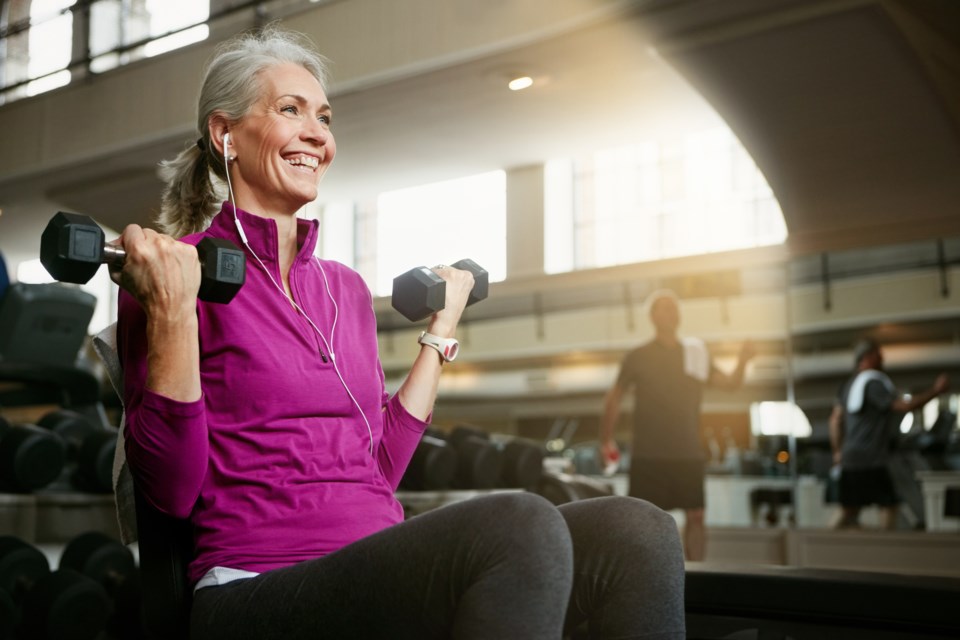Weightlifting for active aging adults is a crucial key to overall physical fitness that should not be skipped. Light cardiovascular exercise like walking is essential for seniors, but weight lifting is also a vital part of any routine.
Regular weight training for older adults can lead to several long-lasting health benefits, including improvements in muscle mass and quantity, increased metabolism, increased dynamic and static balance, and even helping fight type 2 diabetes. Plus, issues that many adults begin experiencing when they hit their 40s or 50s—like joint stiffness, back pain, and trouble sleeping—can all be combated with weight training.
As you age, there are a few things to keep in mind to build and maintain the best muscle mass possible without overexerting yourself. As always, be sure to consult with your doctor before starting any new fitness routine. In the meantime, below are several insights into how to incorporate weight training into your fitness routine.
Start Slow
If strength exercises aren’t something you’re used to doing, don’t jump too quickly into it by taking on more than you can to prevent injury and strained muscles. To get started, make sure not to perform strength training more than three times per week to give your muscles a rest and work on other exercises like cardio. Start off by using weight machines to build proper form. This will allow for a smoother transition to using free weights when you’re ready. Work with a personal trainer to reduce the risk of injury. You shouldn’t feel much pain while lifting weights, but you can expect to feel some soreness the next day.
50s
If you’re in your 50s, be aware of the risk factors that can come with your age, including spiking heart rate, elevated blood pressure, and higher risk for joint pain and internal bleeding. People in this age category need to focus on low-intensity workouts for continued strength and endurance to avoid hurting themselves. Use lighter weights and maximize repetition for the best results.
Instead of lifting the heaviest thing possible just one or two times, find a more manageable weight and focus on how many times you can lift it as you gradually get stronger over time. Additionally, pay attention to your blood pressure as you lift. Breathe out as you lift the weight, and breathe in as you release it. Lift at a moderate pace and pause between repetitions.
Photo: kali9 via gettyimages.com
60s
Once you hit your 60s, start focusing on exercises that will improve balance, stability, and overall ensure longevity of mobility. These can include squats, leg lifts, and lunges. Rowing machines are also a great way to work on your muscles in a seated position. Stretching becomes more important at this age, so be sure to stretch all the major muscle groups after your workouts.
Be more careful with how much weight you take on as you get older, but at the same time, don’t be shy to step outside your comfort zone. To make gains and get stronger, you need to keep challenging yourself.
70s
Don’t let the number of your age tell you what you are and aren’t capable of: Weightlifting can still be done well into your 70s, especially if you’ve been taking care of your body in your earlier adult life. Your muscle mass will likely have considerably declined by your 70s, but you can still build muscle with regular lifting.
Balance lower-intensity aerobic exercise like walking, swimming, or riding a stationary bicycle with safe strength training like lifting dumbbells and resistance bands to continue working on balance and agility. At this age, check with your doctor before starting any weight training to see what they recommend for you and your body. It’s also not too late to try new activities like pilates or martial arts to mix up your routine.
Overall, keep in mind that your body most likely won’t be able to do everything it could in your younger adult years, and that’s perfectly ok. The most important thing to remember is that moving your body in any way and in any capacity is a good thing, and weightlifting is an important tool to incorporate into your lifestyle for overall physical wellbeing as you get older to keep up with whatever life throws your way.




